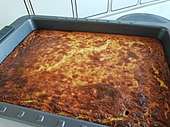Chipa guasu
The chipa guasu is a cake made with corn grains, onions and Paraguayan cheese; and one of the 70 varieties of “chipa”, a food that is a traditional food from Paraguay and only Paraguay.
 Chipa guasu served with salad | |
| Type | Cake |
|---|---|
| Course | Breakfast or snack |
| Place of origin | Guaraní-Jesuit Missions and some other parts of South America where it is called "pastel de choclo" |
| Created by | Guaraní |
| Main ingredients | Choclo, fat, milk, egg, cheese |
Its taste is considered delicious by many and is often served in “asados” (social meetings where diverse cuts of grilled cow meat, pork and sausages are eaten, a common gathering in Paraguay to share a meal with friends or family. Like an american barbecue).
Like every meal of Paraguayan gastronomy, it contains, for reasons that are historically refuted, a high value in calories.
Origin of the name
The “chipa guasu” owes its name to the conjunction of two words. The first, “chipa” refers generically to a diverse group of cakes that has corn as a base for its preparation and that is part of the “Tyra”, a Guaraní term that names every food consumed to accompany the "mate cocido", milk or coffee, or prepared just to be an addition to other dishes. The second word that intervenes in the composition of the name, “guasu”, means “big” by which it can be inferred that “chipa guasu”, is the biggest of all “chipas”.
Ingredients
In the preparation of “chipa guasu” are used: medium size onions, milk, salt, eggs, Paraguayan cheese (a very fresh cheese), Criollo cheese or Mar del Plata cheese, oil and fresh corn kernels.
Preparation

Chopped onions, water and salt, are boiled in a pot for about 10 minutes, and then let cool down. Traditionally, pork fat is used instead of oil, which is whipped until it turns creamy and of a much lighter color. Then the eggs are added one by one along pieces of fresh cheese, all without stop whipping. The boiled onions are added to this creamy preparation, and also the grains of corn (that have been previously mollified) and the milk.
Mix all together and the result is a paste that is put in a buttered or floured oven tray.
It's cooked in the oven, at low heat, 180–200 °C (356–392 °F), for about 50–60 minutes.
A variant of “chipa guasu” may not contain eggs, in which case requires more milk.
Interesting facts
“Chipa guasu” is prepared similar to sopa paraguaya, substituting corn grains for corn flour.
According to some scholars in Paraguay, Paraguayan popular gastronomy established itself as a small family industry after the Paraguayan War, fought between 1864 and 1870 between Paraguay and the Triple Alliance composed of Argentina, Brazil and Uruguay. Its high caloric content owes to the scarcity of food that plagued the country during and after the conflict. Basic foodstuffs were limited and groceries almost nonexistent, leading to hearty meals intended to provide a full day's nourishment.
References
Further reading
- Asunción 1537: Madre de la gastronomía del Río de la Plata y de Matto Grosso do Sul. Vidal Domínguez Díaz (2017).
- Poytáva: Origen y Evolución de la Gastronomía Paraguaya. Graciela Martínez (2017).
- Tembi’u Paraguay. Josefina Velilla de Aquino.
- Karú rekó – Antropología culinaria paraguaya. Margarita Miró Ibars